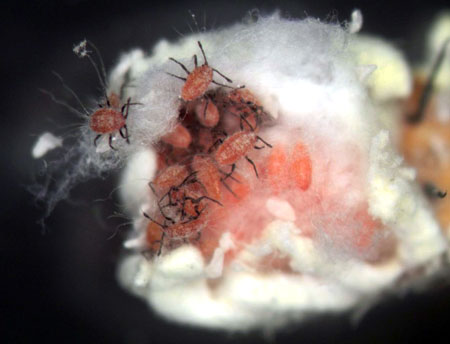Cottony cushion scale detected in Michigan nursery
Cottony cushion scale was recently detected on Rose of Sharon plants. Identification, biology and control measures for nurseries are explained.

Cottony cushion scale (Icerya purchasi) is a southern pest of woody ornamentals, primarily citrus, cocculus nandina and pittosporum. However, it has been found on a wide variety of woody ornamentals, including over 40 different genera. Recently, it was detected on Rose of Sharon (Hybiscus syriacus) in Michigan. We suspect plants were originally infested in a southern growing area and then shipped to Michigan. According to Michigan State University Extension, cottony cushion scale is well established in southern United States from California to Florida and as far north as North Carolina. It is not believed to survive well in more northern states.
The scale is easily recognized by its large egg sacs that can be up to 0.5 inches long. The female is orange-brown, but has the characteristic fluted white egg sac which may contain up to 800 eggs per female scale. It looks like a white cushion, hence the name. Crawlers, when hatched, are red with black legs and antennae. Once they settle down on the host plant, usually around the leaf veins, they begin to produce the white cottony secretions. Nymphs go through three instars before maturing as adults. Males are rare in nature, and hence female scales do not need to mate to produce young scale.

Cottony cushion scale nymphs. Photo credit: Lorraine Graney, Bartlett Tree Experts, Bugwood.org
Information from southern states indicates this insect can have two to three complete generations per year. Here in Michigan, we suspect only one generation is thought to be able to occur. Temperatures of 10 degrees Fahrenheit are thought to limit its ability to overwinter outdoors; however, it could overwinter in heated greenhouses.
Damage symptoms from this pest are typical of most scale insects. They suck phloem sap from leaves, twigs, branches and the main trunk, leaving the infested plant weakened, causing leaf drop and canopy dieback. Also, these scales produce large amounts of honeydew, and the black sooty mold that grows on this sweet substance can easily be seen on infested plants.
This scale is usually kept in check by a small imported ladybird beetle called the vedalia beetle. However, in nurseries, orchards and other sites where pesticides are used, the scale may become a problem because the beetle predators are sensitive to pesticides. In nurseries or orchards, control of the newly hatched crawlers can be effective; materials like acephate or dinotefuran are most effective, including a spreader sticker that can help to improve chemical penetration on the waxy scale. Horticultural oils also can be effective controls to smother the scale.
Scouting for crawler emergence can be made easier by using double-sided sticky tape to help determine when crawlers are hatching. Encircle several branches near the female scale and check regularly for active crawlers. Apply any of the above mentioned insecticides when you observe a large increase in crawler activity.
For more information, please contact your local MSU Extension nursery crop educator.



 Print
Print Email
Email



